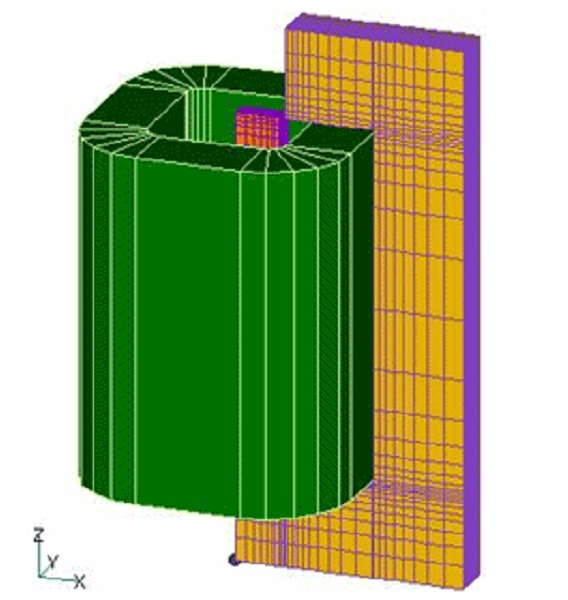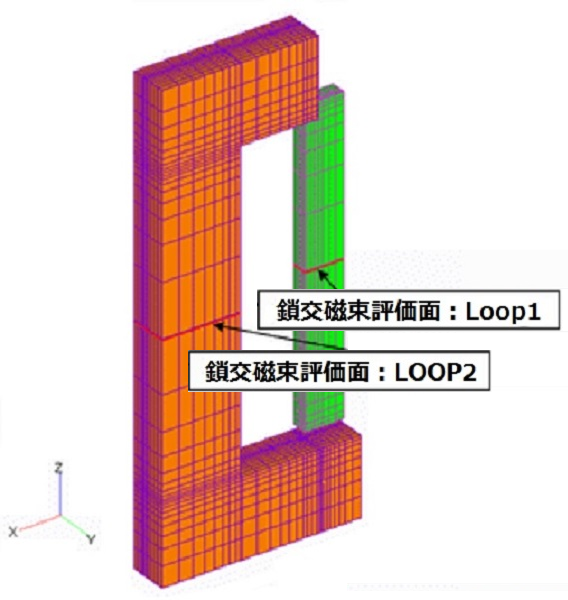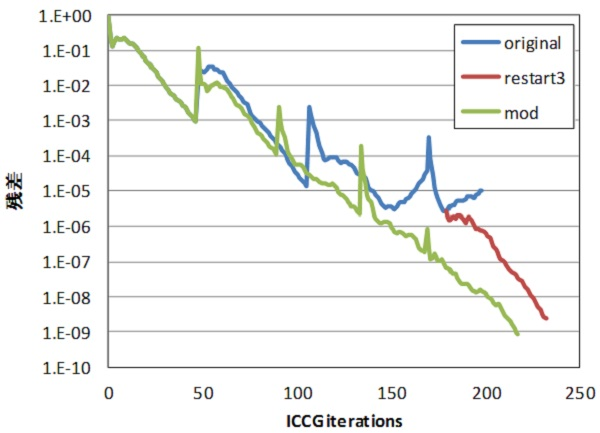Restart analysis function for changing convergence conditions
- TOP >
- Analysis Examples by Functions (List) >
- Restart analysis function for changing convergence conditions
Summary
As discussed in “Convergence Conditions and Analytical Accuracy”, convergence conditions for the ICCG and Newton-Raphson methods are a major issue in obtaining the necessary accuracy. To obtain high accuracy, the convergence conditions must be strict, but this increases the computation time. In addition, if the convergence is too slow or if the convergence calculation is terminated at the maximum number of iterations of the Newton-Raphson method (NONLINEAR_ITERATIONS), there are cases in which sufficient accuracy has not been obtained. In such cases, the conventional EMSolution requires recalculation from the beginning with stricter convergence conditions, which is computationally expensive, especially in the case of three-dimensional analysis. We have now added a restart analysis function that takes the once-computed results as initial values and performs the analysis with stricter convergence conditions.
Explanation
The following is an example of TEAM Workshop Problem 20 (Fig. 1) used in “Convergence Conditions and Analysis Accuracy”.
First, let us analyze the original data in the benchmark. Fig. 2 shows the number of ICCG iterations and residuals for the cases with coil current of 1 kA (first step).
The original convergence condition (ORIGINAL) is poor, and the ICCG method diverges without satisfying the convergence condition (ICCG_CONV=1.0e-6) in the final step of the Newton-Raphson method. However, the maximum value of the magnetic field change ($\delta B_{max}$) is 3.23e-3T, which is sufficiently convergent, and it has been demonstrated in the literature [1] that even under the ORIGINAL condition, the ICCG method is accurate in comparison with the measured values, but the divergence of the ICCG method may be questionable. Subsequent additional functionality has shown that the convergence can be improved by using the following settings, and indeed recalculation under these conditions (mod) shows that the method converges to $\delta B_{max}$ = 0.01T or less (on the order of 1.0e-9 in the ICCG residuals) in slightly more steps than the original.
- REGULARIZATION=1: Option to reduce errors in magnetic field sources
- LINE_SEARCH=1: Option to increase the stability of the Newton-Raphson method with the line-search method
- CHECK_B = -0.01: Option to specify $\delta B_{max}$ < 0.01T as the non-linear convergence decision value
The computation time is about the same for both original and mod, about 30 seconds for 4 steps, but analyzing the same problem twice by changing only the convergence conditions means that the calculation cost is twice as much.
Therefore, by applying the restart analysis function for changing convergence conditions, a new function that was added this time, to the calculation using the original result as the initial value and reflecting the mod setting (restart3), the calculation starts from the residual of the final step of the original and converges immediately to the same level as the mod. The calculation time is only 8 seconds. Table 1 shows the calculation results for the interlinkage flux. As a result, even the results of original agrees with the results of mod up to the fourth significant digit, which is sufficiently accurate. The results of mod and restart3 with stricter convergence conditions agree up to the fifth significant digit, so it can be assumed that they have almost reached the same solution.
Table 1 Interlinkage flux results
| Interlinkage flux (Wb) | ||||
|---|---|---|---|---|
| original | mod | restart3 | ||
| 1000A | Loop1 | 4.42284E-05 | 4.42287E-05 | 4.42287E-05 |
| Loop2 | -4.16667E-05 | -4.16671E-05 | -4.16671E-05 | |
| 3000A | Loop1 | 1.11718E-04 | 1.11718E-04 | 1.11718E-04 |
| Loop2 | -1.12385E-04 | -1.12385E-04 | -1.12385E-04 | |
| 4500A | Loop1 | 1.25318E-04 | 1.25319E-04 | 1.25319E-04 |
| Loop2 | -1.37195E-04 | -1.37195E-04 | -1.37195E-04 | |
| 5000A | Loop1 | 1.28069E-04 | 1.28069E-04 | 1.28069E-04 |
| Loop2 | -1.43926E-04 | -1.43927E-04 | -1.43927E-04 | |
This function is available for static (STATIC), AC steady (AC), and transient (TRANSIENT) fields.
The rest of this page is for members only.
Analysis Examples by Functions
Convergence property improvement and speed-up methods
- Problems with flat tetrahedral elements and their countermeasures
- Node-second-order edge-first-order elements
- Joining hexahedral and tetrahedral elements
- Improved convergence of flat and elongated elements
- Fast convergence to steady-state solutions of time-periodic problems
- Steady-State Analysis of Induction Motors Using a Simplified Time-Periodic Method
- Steady-State Analysis of Rotating Machines by Simplified Multi-Phase AC EEC Method
- Parallel computing capability with OpenMP
- Restart analysis function for changing convergence conditions
©2020 Science Solutions International Laboratory, Inc.
All Rights reserved.





